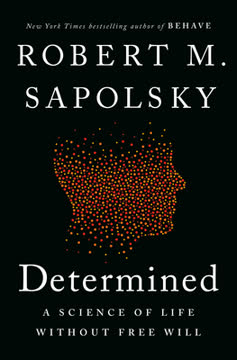Key Takeaways
1. Your brain is uniquely yours, shaped by genetics and experience
"Your brain makes you that way."
Nature and nurture interplay. Your brain's unique characteristics are a result of both genetic predisposition and life experiences. This interplay shapes your thoughts, feelings, and behaviors, making you distinctly you. The human brain, with its 86 billion neurons, is incredibly complex and adaptable.
Individual differences matter. While all human brains share common features, the variations between individuals can be significant. These differences manifest in various ways:
- Brain size and structure
- Neurotransmitter levels
- Neural connectivity patterns
- Information processing speeds
- Cognitive strengths and weaknesses
Understanding these individual differences is crucial for appreciating human diversity and developing personalized approaches to education, mental health, and personal development.
2. The two hemispheres of your brain work differently but collaboratively
"Though it might be hard to believe, your brain works something like this: In its version of Telephone, the whispering between neurons is accomplished by the release of neurotransmitters."
Hemispheric specialization. The left and right hemispheres of the brain have different computational styles and strengths:
- Left hemisphere: More focused on details, language processing, and logical reasoning
- Right hemisphere: Better at holistic thinking, spatial awareness, and emotional processing
Collaboration is key. Despite these differences, the two hemispheres work together to create a unified experience of the world. The corpus callosum, a bundle of nerve fibers connecting the hemispheres, allows for rapid information exchange and integration.
The degree of lateralization (how strongly functions are divided between hemispheres) varies between individuals and can influence cognitive strengths and weaknesses. Understanding your own hemispheric balance can help you leverage your brain's natural tendencies and compensate for potential weaknesses.
3. Your brain's chemical balance influences your personality and behavior
"At the end of the day, if you're trying to explain what makes people perform differently on intelligence tests, knowing how big their brains are will get you almost 11 percent of the way there."
Neurotransmitter cocktail. Your brain's unique mix of neurotransmitters, including dopamine, serotonin, and oxytocin, plays a crucial role in shaping your personality and behavior. This chemical balance influences:
- Mood and emotional regulation
- Motivation and reward-seeking behavior
- Social bonding and empathy
- Anxiety and stress responses
Dynamic system. Your brain's chemical balance is not static; it can be influenced by:
- Genetics
- Diet and exercise
- Sleep patterns
- Stress levels
- Social interactions
- Environmental factors
Understanding your brain's chemical tendencies can help you make informed decisions about lifestyle choices and potential interventions to optimize your mental well-being and performance.
4. Neural synchronization affects how you process information
"To better understand the relation between focus and mind control, we'll need to get into more of the details of this design feature."
Brain rhythms matter. The synchronization of neural activity at different frequencies influences how your brain processes information. Key points:
- Alpha waves (8-12 Hz): Associated with relaxed alertness and creativity
- Beta waves (13-30 Hz): Linked to focused attention and problem-solving
- Theta waves (4-7 Hz): Important for memory consolidation and learning
- Gamma waves (30-100 Hz): Involved in higher-order cognitive functions
Individual differences in synchronization. People vary in their dominant neural frequencies and ability to shift between different brain states. These differences can affect:
- Attention span and focus
- Learning and memory capacity
- Cognitive flexibility
- Creative thinking abilities
Understanding your brain's rhythmic tendencies can help you optimize your environment and activities for better cognitive performance and well-being.
5. Your brain adapts to your environment, creating your personal reality
"You are neither an actor in nor the passive observer of your reality. You are the creator of it."
Neuroplasticity in action. Your brain constantly rewires itself based on your experiences, a process known as neuroplasticity. This adaptation shapes your perception of reality and influences your thoughts, emotions, and behaviors.
Personal reality construction. Key factors in how your brain creates your subjective experience:
- Selective attention: Your brain filters incoming information based on relevance and past experiences
- Pattern recognition: Your brain seeks to find familiar patterns in new situations
- Memory integration: New experiences are interpreted in light of past memories
- Emotional coloring: Your emotional state influences how you perceive and remember events
Understanding that your reality is a construction of your brain can help you:
- Be more open to different perspectives
- Critically examine your own biases and assumptions
- Actively shape your experiences to promote positive brain changes
6. Curiosity and exploration shape your brain's knowledge and decision-making
"Curiosity is often portrayed as a desirable feature. However, curiosity may come at a cost that sometimes puts people in harmful situations."
Curiosity as a driving force. Curiosity motivates exploration and learning, leading to the expansion of your brain's knowledge base. The benefits of curiosity include:
- Enhanced memory for new information
- Increased dopamine release, promoting positive feelings and motivation
- Improved problem-solving abilities
- Greater adaptability to new situations
Balancing curiosity and caution. While curiosity is generally beneficial, it's essential to balance it with:
- Risk assessment: Evaluating potential dangers of exploration
- Impulse control: Managing the urge to seek immediate gratification
- Resource allocation: Deciding where to focus your attention and energy
Cultivating healthy curiosity while maintaining appropriate caution can lead to a richer, more fulfilling life experience and better decision-making.
7. Understanding others requires flexible mind modeling and connection
"People are hard to hate close up. Move in."
Theory of mind. The ability to understand and predict others' mental states, known as theory of mind, is crucial for social interaction and empathy. This skill involves:
- Perspective-taking: Imagining yourself in another's position
- Emotion recognition: Interpreting facial expressions and body language
- Contextual understanding: Considering situational factors that influence behavior
Flexible mind modeling. Effective social interaction requires adapting your mental models of others based on new information and experiences. This flexibility allows for:
- Better communication and conflict resolution
- Increased empathy and compassion
- Improved teamwork and collaboration
- Reduced prejudice and stereotyping
Developing your mind-modeling abilities can lead to richer, more meaningful relationships and enhanced social functioning in various contexts.
Last updated:
FAQ
1. What is The Neuroscience of You by Chantel Prat about?
- Exploring brain individuality: The book explains how every brain is uniquely shaped by biology and life experiences, influencing how we think, feel, and behave.
- Beyond one-size-fits-all neuroscience: Prat delves into individual differences in brain structure, chemistry, and function, challenging common myths about the brain.
- Personal and scientific blend: The author combines neuroscience research with personal stories to make complex concepts relatable and practical for everyday life.
2. Why should I read The Neuroscience of You by Chantel Prat?
- Gain self-understanding: The book helps readers understand their own brain’s unique design, strengths, and challenges, fostering greater self-awareness.
- Practical insights for life: It offers assessments and explanations that empower readers to apply neuroscience to personal growth, relationships, and decision-making.
- Empathy and connection: By highlighting how brains differ, Prat provides tools for better communication and empathy in social and professional settings.
3. What are the key takeaways from The Neuroscience of You by Chantel Prat?
- Every brain is different: Individual differences in brain structure, chemistry, and rhythms shape our thoughts, behaviors, and personalities.
- Nature and nurture interplay: Genetics and life experiences both play crucial roles in shaping the brain, making it a dynamic, ever-changing organ.
- Understanding leads to empowerment: Awareness of your brain’s unique wiring can help you leverage your strengths and navigate challenges more effectively.
4. What are the best quotes from The Neuroscience of You by Chantel Prat and what do they mean?
- “Your brain is a moving target.” This highlights the brain’s constant adaptation to new experiences and environments.
- “There is no such thing as a ‘normal’ brain.” Prat emphasizes that brain diversity is the norm, not the exception.
- “The horse and rider must learn to work together.” This metaphor illustrates the partnership between intuitive and controlled brain systems in guiding behavior.
5. How does The Neuroscience of You by Chantel Prat explain brain lateralization and handedness?
- Lopsided brains explained: Human brains are structurally asymmetrical, with hemispheres specializing in different types of processing.
- Handedness as a marker: Hand preference reflects underlying brain lateralization, with most people being right-handed and left-hemisphere dominant for language.
- Costs and benefits: Highly lateralized brains may excel in specific tasks but are more vulnerable to injury, while balanced brains are more resilient and integrate information more globally.
6. What is the “horse and rider” metaphor in The Neuroscience of You by Chantel Prat?
- Horse as intuition: The horse represents the brain’s intuitive, automatic, and reward-driven systems, learning from experience without conscious awareness.
- Rider as conscious control: The rider symbolizes the prefrontal cortex, using language and explicit goals to guide behavior, but can tire quickly.
- Interaction and learning: With practice, the rider can train the horse, making controlled behaviors more automatic over time.
7. How does The Neuroscience of You by Chantel Prat describe the role of neurotransmitters in personality and behavior?
- Dopamine and extraversion: Dopamine drives reward-seeking and motivation, with extraverts showing stronger responses to unexpected rewards.
- Serotonin and emotional balance: Serotonin helps regulate mood and inhibits excessive dopamine-driven wanting, influencing anxiety and stability.
- Stress and neurochemistry: Stress hormones interact with neurotransmitter systems, affecting creativity, motivation, and mental health.
8. What does The Neuroscience of You by Chantel Prat say about neural rhythms and brain synchronization?
- Brain as a rhythm generator: Neurons communicate in rhythmic cycles, coordinating information flow and enabling flexible task management.
- Alpha frequency and cognition: Preferred alpha rhythms correlate with working memory and processing speed, with faster rhythms supporting multitasking and slower ones linked to creativity.
- Trade-offs in synchronization: High-frequency rhythms aid real-time processing but limit integration, while low-frequency rhythms support integration but can cause attentional lapses.
9. How does The Neuroscience of You by Chantel Prat explain attention, focus, and the basal ganglia’s role?
- Hierarchy of focus: Attention ranges from automatic noticing to controlled, goal-directed focus and self-monitoring.
- Basal ganglia as conductor: These brain nuclei route relevant signals based on context and goals, collaborating with the prefrontal cortex for decision-making.
- Learning through dopamine: The basal ganglia use dopamine feedback to prioritize signals, shaping flexible, goal-directed behavior.
10. How does The Neuroscience of You by Chantel Prat describe reinforcement learning and the “carrot and stick” method?
- Four-step process: The brain builds environmental models, considers actions, selects those with the highest expected reward, and updates based on outcomes.
- Dopamine’s dual role: Dopamine surges signal positive outcomes (“carrot”), while dips signal negative outcomes (“stick”), shaping learning.
- Individual differences: People vary in their sensitivity to reward versus punishment, influencing their learning and decision-making styles.
11. What does The Neuroscience of You by Chantel Prat reveal about memory, meaning maps, and knowledge representation?
- Declarative and procedural memory: The rider uses declarative memory for facts and experiences, while the horse relies on procedural, intuitive memory.
- Meaning maps in the brain: Semantic knowledge is distributed in patterns of brain activation, organized by themes like function or use.
- Individual differences: Personal experience and attentional focus shape how concepts are represented and retrieved in the brain.
12. How does The Neuroscience of You by Chantel Prat connect curiosity, social connection, and understanding others’ minds?
- Curiosity as a motivator: Curiosity activates dopamine circuits, enhancing learning and memory by signaling anticipated knowledge rewards.
- Oxytocin and bonding: Oxytocin boosts social pleasure and reduces stress, motivating connection and influencing bonding behaviors.
- Mind modeling and teamwork: Skills like reading emotions and theory of mind improve empathy, communication, and collective intelligence in groups.
Review Summary
The Neuroscience of You explores how individual brain differences shape thoughts, behaviors, and personalities. Readers praised its accessible writing style, engaging anecdotes, and practical tests. Many found it informative and insightful, appreciating the author's emphasis on brain uniqueness and individual differences. Some criticized excessive footnotes and tangents. Overall, the book was well-received for its fresh perspective on neuroscience, focusing on individual brain variations rather than averages, and offering readers a deeper understanding of themselves and others.
Similar Books








Download PDF
Download EPUB
.epub digital book format is ideal for reading ebooks on phones, tablets, and e-readers.




